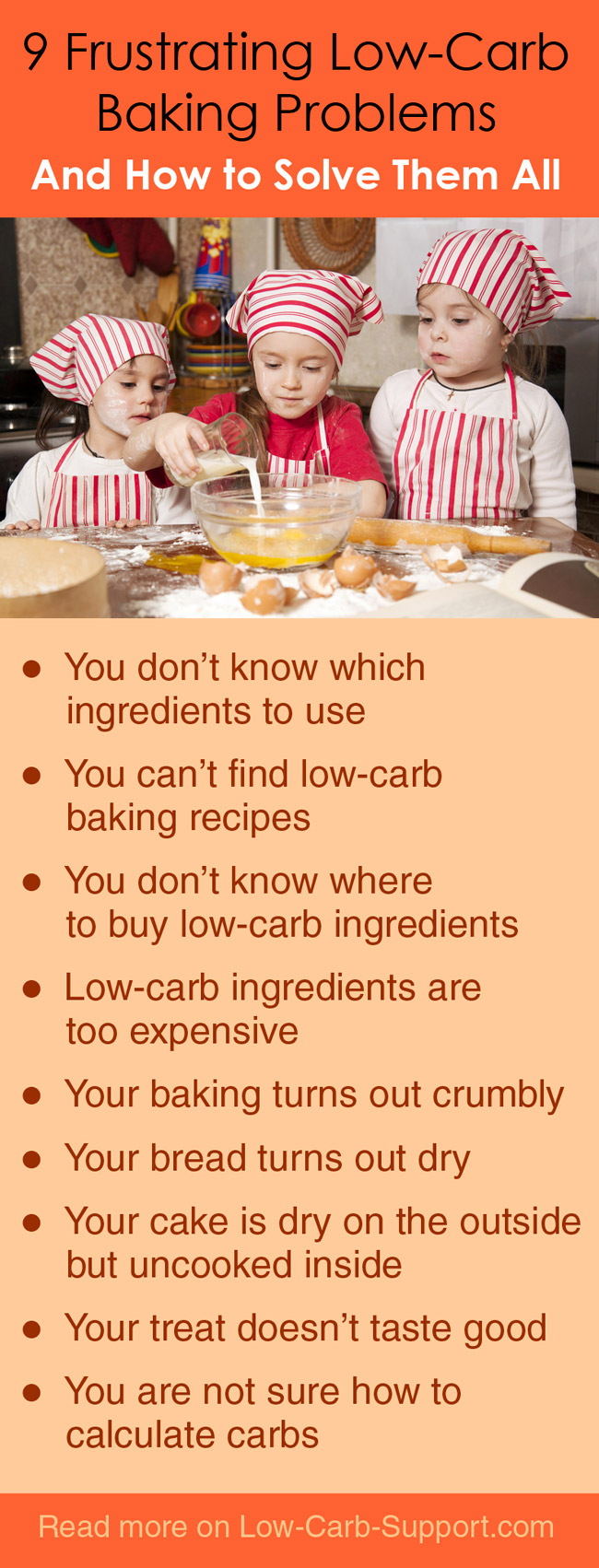 Are you afraid of walking past a bakery?
Are you afraid of walking past a bakery?
Can you hear cakes whispering tempting promises? Knowing they are full of sugar doesn’t make them less desirable.
The rich fudgy texture of brownies. Butter melting on a fresh baguette. Scrumptious birthday cake.
You don’t have to say goodbye to your favourite treats. Because you can adapt them for low-carb lifestyle.
Baking the low-carb way is easy.
It is quicker than traditional baking. You don’t need to raise or knead the dough. Just mix the batter and stick it in the oven.
And the best part? You control exactly what goes in your treats. No hidden carbs. No chemical nasties. And you can calculate net carbs precisely.
Ready to start baking your own low-carb treats?
This post answers the most common low-carb baking questions, so you can bake (and enjoy!) your favourite treats again. Without guilty feelings. And without hassle.
When you don’t know which ingredients to use…
The concept of low-carb bread seems odd. Surely, bread and cakes are bound to be high in carbs?
Traditional baking uses wheat flour and sugar. That’s where most of the carbs come from. The secret is you don’t have to use them!
Substitute high-carb ingredients as follows:
| Traditional baking ingredient | Low-carb substitute |
| Traditional flours Wheat, rye, rice, tapioca, oats 70-80g net carbs |
Flours made from nuts and seeds ground almonds 5-20g net carbs |
| Sugar 100g net carbs |
Artificial sweeteners Truvia 0g net carbs |
| Flavourings
Vanilla extract (and other flavours) Chocolate Cacao powder |
Sugar-free flavourings
sugar-free vanilla extract 100% cacao sugar-free chocolate sugar-free cocoa powder |
Please note that direct substitution doesn’t work. You need to adapt quantities, too. The easiest way is to use an existing low-carb recipe.
When you can’t find any low-carb baking recipes…
Low-carb lifestyle is still niche. The mainstream is catching up on the evils of sugar, and one day they will throw it away – but not yet. So don’t expect to find suitable recipes on BBC Food.
But when you know where to look, you can find hundreds of tried and tested recipes for low-carb baking. And thousands of inspiring photos of gorgeous low-carb food.
Popular low-carb recipe blogs:
Low-carb food on photography websites:
Low-carb baking cookbook:
Please also check out:
- Low-carb baking recipes on this website
- My collections on Pinterest: Low-carb baking, Low-carb bread
- Google+ communities: Low Carb Support, Atkins Diet
When you don’t know where to buy low-carb ingredients…
Some low-carb ingredients are already on the High Street. Coconut flour is everywhere. Others, like xanthan gum, are elusive.
Your best bet is to shop online. Find a low-carb shop, or head to Amazon.
Online Low Carb Shops
Low Carb Connoisseur
Delivery to USA
The Low Carb Grocery
Delivery to Canada
Amazon
Low Carb Baking Ingredients on Amazon UK
Low Carb Baking Ingredients on Amazon USA
When low-carb ingredients are too expensive…
We are used to sugar and wheat being cheap. They are highly refined foods. The huge food industry breeds special strains of plants for easy processing.
Making nuts into flour is harder. Hard shells need cracking. Nut kernels need grinding, de-fatting, drying, and grinding again. Not as many producers are in this market. Some of them are just tiny farms. So production costs are higher.
Only you can make the decision about food’s quality vs cost.
Take steps to lower the costs:
- Buy ingredients in bulk. The more you buy, the cheaper it is. For example,
1kg of Suma Ground Almonds costs £19.97 on Amazon, whereas 5 kg pack costs £70 – you save £30 (prices as at July 2015).Don’t worry about ingredients going off. The standard “best before” date on dried nuts products is a guideline. In Europe, 2 years is the maximum allowed shelf life, even if it’s much longer in reality. Nut flour is not going to go off like milk or meat. You can keep it for years if stored properly. - Subscribe to regular purchases. Amazon gives you around 5% off if you subscribe. Not a huge saving, but every little helps.
- Use cheaper ingredients to bulk expensive ones. Add vegetables – grated courgettes, pureed pumpkin and mashed cauliflower. Flax tends to be cheaper than nut flours too.
When your baking turns out crumbly…
You bite into a gluten-free brownie. It is sweet, rich and chocolatey. If only it wasn’t showering crumbs all over your clothes…
Unlike traditional flours, low-carb flours are gluten-free. Gluten is a protein found in wheat. It makes dough supple. Without gluten, baked goods are fragile and crumbly. They try to fall apart on the first bite.
To make your baked goodies more elastic, add one of these ingredients in place of gluten:
Protein is the key. Use lots of eggs and egg whites. Or try adding plain protein powder to your recipe.
When your bread turns out dry and dense…
Low-carb bread can turn out more like a brick than a baguette! But it doesn’t have to.
Use plenty of liquid in your recipe – a lot more than in traditional recipes. Your batter should be quite thin. With some recipes, it is pourable. Spend several minutes mixing the batter to incorporate more air.
But you might have to compromise a little.
And get used to new textures. For breads, expect results closer to heavier rustic multi-seed breads, than a fluffy baguette. It will still work perfectly with pâté, ham and any other topping.
When your cake dry on the outside but uncooked inside…
A low-carb cake comes out of the oven looking perfect. You’re licking your lips. It looks gorgeous.
But the cake hides a shameful secret – gloopy uncooked mass in the centre.
How disappointing!
Low-carb baking needs longer times at lower oven temperatures, so that the moist inside has time to catch up.
Adjust your expectations for cooking times and temperatures. Always follow the directions on your recipe precisely.
When your treat just doesn’t taste good…
Coconut flour with sweetener tastes different to wheat flour and sugar. Sometimes we dislike a taste just because it’s not what we expected.
If you don’t like the taste of nut flours or sweeteners, add strong flavours to your recipe.
Sweet baking – flavours for cakes and biscuits
- Chocolate – unsweetened cocoa powder or sugar-free baking chocolate
- Orange or lemon – sugar-free flavour extracts, or grated zest and juice
- Spices – vanilla, cinnamon, nutmeg, cardamom, cloves, anise seed, lavender
- Almond extract or amaretto
Savoury baking – flavours for breads and crackers
- Herbs – rosemary, oregano, sage, chives, basil
- Spices – pepper, allspice, nutmeg, cardamom, chilli flakes
- Seeds – sunflower, poppy, caraway, fennel, chia
- Vegetables – garlic (powdered or fresh), onion (dried flakes or minced), sun-dried tomatoes, olives
- Meat and cheese – cheddar, parmesan, crumbled bacon
When you are not sure how to calculate carbs…
Don’t count the carbs inside your head. Even if you are great at maths, your brain will trick you. Humans always err on the wrong side when it comes to food. That’s our evolutionary heritage.
Use an app, a spreadsheet, or at least pen and paper.
- Look up the carb content for the correct quantity of each ingredient
- Add up the counts for all ingredients
- Check how many servings you have – for example, most cakes are cut into 8, and bread loaves into 8-10 slices
- Divide the total number of carbs by the number of servings.
So a cake with 1600 total calories and 40g net carbs, cut into 8 slices, will have 200 cals and 5g net carbs per slice.
Food tracking apps
These apps include tools to calculate macronutrients for a recipe. They are free but require registration:
Websites to look up carb counts
- Atkins free tools
- US Department of Agriculture National Nutrient Database
Carb counter pocket guides
You can bake scrumptious low-carb treats
Yummy low-carb treats help you fight temptation.
Enjoy your food without breaking your diet.
Walk past a bakery with your head held high.

So I’ve tried a couple of chocolate cake recipes. Both came out quite salty even after following the recipes exactly. First recipe was to add salt and it was super salty. Second recipe did not call for salt. But still was salty. Only thing I can think of was maybe the sweeter I used. Both times I used Swerve. Any thoughts??
Thanks for the tips! What would you recommend in terms of temperature and timing for keto cakes and breads? I keep getting overly dark outsides and not-quite cooked centers. I have decreased my temperature by 25 degrees, and added more cooking time, but still haven’t seemed to get it right. 🙁
What is the best way to store keto baking I find that after storing biscuits, rolls or bread in air tight containers they go very soft and lose any crispness they had.
Hi Anamarie, yes, indeed they do! I tend to just loosely cover them with foil and leave them out of the fridge. Sometimes they dry up a bit this way, but that usually makes them taste better. I also put Keto cakes in the fridge without any container or cover, and it seems to be ok.
Thank you. All great information. I also greatly appreciate links to specific sources.
Thank you Tina 🙂
With diagnosed metabolic syndrome disorder and morbidly obese, my doctor has placed me on a modified Ketogenic program. I have reduced my carb intake, except where white wheat flour tortillas are concerned. Being of Hispanic descent, I need a recipe that doesn’t use xanthum gum or non-gluten flours that have carbs that will cause me to exceed my 5-7 carb gram meal limit. Next option will have to be bariactric surgery in 6-7 months.
Hi Gonzoh, have you tried making tortillas with coconut flour? Here’s one recipe: https://www.ketoconnect.net/recipe/low-carb-tortillas/
I really hope Keto diet will work out for you, so that you won’t need the surgery. Best of luck!
La Banderita make white and wheat low carb tortillas with 5 net carbs in each. They are delicious! I find them at Food lion and Wal Mart
There are now low carb tortillas available in most store tortilla section.
What is the quantity adjustment for the low carb sub ingredients?
i.e. The recipe that calls for 2 or 3 cups of regular flour how much coconut flour or almond flour would that adjust to? Most all low carb recipes I’ve tried have substantially less “flour” in them than their wheat flour originals. Any guidelines for starting ratios?
My current adjustment question comes from a recipe that uses 2tbs of flour (for thickening a cream sauce (alfredo).
Thanks!
Hi Aurora
As mentioned in the post, it’s usually not as simple as just swapping regular flour to coconut or almond flour. You are right that required quantities tend to be smaller. But there is a lot more to it. Low-carb flours have different chemical properties compared to regular wheat-based flour. So usually you also need to add or adjust other recipe ingredients to compensate for these differences. That’s why I recommend using low-carb recipes rather than adapting regular ones – that takes a lot of trial and error.
For thickening sauces, I personally tend to use xanthan gum – you only need a tiny amount for thickening. I also use it in low-carb baking to improve texture and reduce crumbliness.
I just wanted to say how thrilled I am to see that you linked to my site as possible recipe source. Thank you so much. You share great information in this wonderful article.
Thank you Kim 🙂 I love your recipes and I know how hard you must work in order to keep publishing new ones regularly. Thank you!